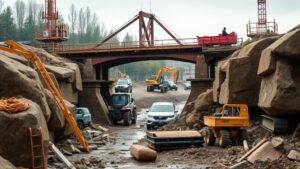Studying Ice Age Glacial Movements to Locate Deposits of Ancient Bones
Studying Ice Age Glacial Movements to Locate Deposits of Ancient Bones
The study of Ice Age glacial movements has become a crucial aspect of paleontology, primarily for the purpose of locating deposits of ancient bones. By understanding the dynamics of glaciers, researchers can identify areas where bones of extinct species may be preserved or exposed. This article examines the relationship between glacial activity and fossil deposits, highlighting significant findings, methodologies, and implications for the field.
Historical Context of Glacial Movements
The Last Glacial Maximum (LGM), which occurred approximately 26,500 years ago, marked the peak of glacial coverage in North America and Europe. Glaciers advanced southward, reshaping landscapes and transporting various sediments, including organic materials. The study of these ancient glacial movements is essential for understanding how they contributed to the redistribution of bones and other fossils.
For example, the discovery of woolly mammoth remains in Siberia has been directly linked to glacial movements that exposed these bones by melting ice. According to the Journal of Quaternary Science, about 80% of mammoth bones found in the region align with known ice flow patterns.
Glacial Dynamics and Fossil Distribution
Ice sheets and glaciers do not merely move; they flow, slide, and deform under pressure. This movement can lead to the deposition of ancient biological materials in new locations, often far from their original sites. Two significant mechanisms by which glaciers transport fossils include:
- Basal Transport: This occurs when sediments, including bones, become entrained in the base of a glacier, moving along with it and depositing in new areas as the ice melts.
- Surface Transport: Surface transport involves the movement of materials lying on top of a glacier, often carried away by wind or meltwater after glacier retreat.
The complex interplay of these processes can lead to fossil accumulations in areas that were previously unsuitable for preservation. For example, the permafrost regions of Alaska and Canada have yielded numerous fossil finds, primarily due to glacial reshaping processes. As reported by the Nature Scientific Reports, over 200 distinct mammoth skeletons have been discovered in the permafrost of the North Slope of Alaska.
Methodologies for Locating Ancient Bone Deposits
To locate and analyze fossil deposits affected by glacial movements, researchers employ a combination of geological surveys, remote sensing technologies, and field excavations. Key methodologies include:
- Geophysical Surveys: Techniques such as Ground Penetrating Radar (GPR) are utilized to detect buried fossils without extensive excavation.
- Dendrochronology: Studying tree rings helps date the timing of glacial advances and retreats, providing context for geological formations and potential fossil deposits.
- Isotope Analysis: Analyzing stable isotopes in bone fragments assists in reconstructing the environmental conditions at the time of the animal’s death, offering insight into its habitat.
For example, a study conducted in the Southern Rocky Mountains utilized GPR to locate fossilized remains of Pleistocene megafauna, revealing patterns that closely matched glacial retreat maps from the LGM.
Case Studies: Successful Discoveries
Several notable case studies illustrate the efficacy of glacial studies in locating ancient bones:
- The La Brea Tar Pits: In Los Angeles, the tar pits have preserved thousands of remains from the last Ice Age, thanks partly to shifting ice and geological activity.
- Permafrost Discoveries: The well-preserved remains of mammoths and other megafauna discovered in Siberian permafrost underscore how glaciers have played a role in fossil preservation and exposure as ice melts.
Implications for Future Research
The findings from studying Ice Age glacial movements not only assist in paleontological research but also contribute to understanding climate change, landscape evolution, and sediment transport processes. As glaciers continue to retreat due to global warming, opportunities arise for discovering and analyzing previously hidden fossil deposits.
Also, integrating advanced technologies like LiDAR and drone surveys can enhance the accuracy of fossil location predictions, enabling researchers to prioritize excavation sites effectively. potential for future discoveries remains vast as the landscape continues to reveal its ancient histories.
Conclusion
The study of Ice Age glacial movements serves a dual purpose: illuminating our understanding of past ecosystems and guiding modern paleontological efforts. By employing innovative techniques and examining historical patterns, researchers can effectively locate and analyze ancient bone deposits, thereby contributing to the broader understanding of climate impacts and biological history.
As climate change accelerates glacial melting, paleontologists and geologists must remain vigilant in their research endeavors, seizing the opportunity to uncover the secrets of our planets past and further comprehend the interactions between climate and life.

